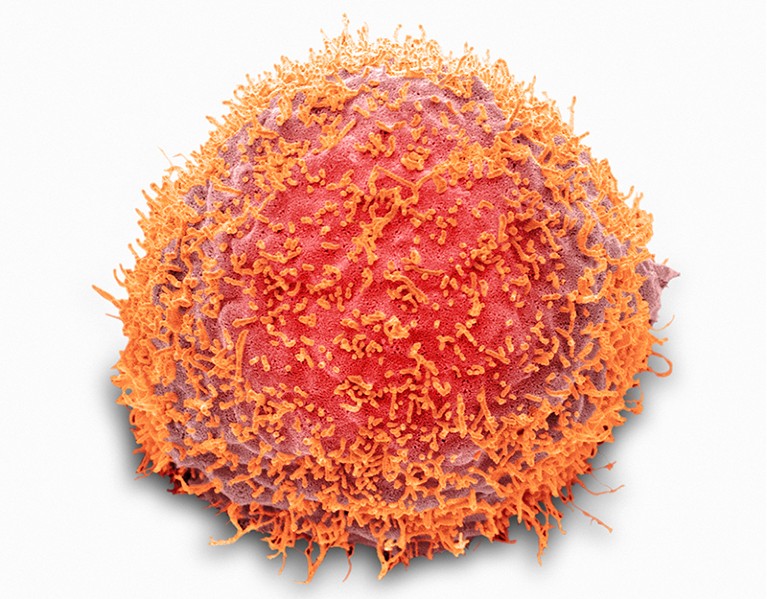Hello Nature readers, would you like to get this Briefing in your inbox free every day? Sign up here

Human cell (artificially coloured) infected with influenza virus, which might have arisen in fish before moving to land animals.Credit: Steve Gschmeissner/Science Photo Library
Corals, sturgeon and other aquatic creatures harbour signs of infection by influenza and its distant relatives. A genetic analysis reveals that the virus family probably originated hundreds of millions of years ago in primordial aquatic animals that evolved well before the first fishes. It’s not clear whether influenza moved onto land with early terrestrial vertebrates, or jumped from sea to land more recently.
Nature | 5 min read
Reference: bioRxiv paper (not peer-reviewed)
An increasing number of wildlife biologists say that wolf packs in the wild aren’t led by a domineering ‘alpha male’ — just good old mum and dad. “He’s just the father of the family,” says wolf researcher L. David Mech. The terminology arose from studying unrelated wolves thrown together in captivity, says Mech — a recipe for discord. In the wild, competition tends to arise in rare cases when there’s plenty of food around and wolf packs balloon in size. “In that case, I personally think the alpha term applies because there is still a dominant female calling the shots in that pack,” says wolf researcher David Ausband.
Scientific American | 6 min read
Features & opinion
Table of Contents
For more than 15 years, scientists have been on a quest: create a functional ‘protoribosome’, a reconstructed version of the protein-building machine that many think might have helped to kickstart life on Earth. The modern ribosome is a key ingredient of life as we know it because it translates genetic information into proteins. At its heart sits a small RNA pocket that some think might be closest to what the very first ribosome looked like. Now, there’s proof that some reconstructed protoribosome-like RNAs can link amino acids — the first step to making proteins. Some scientists say there are other ways for proteins to emerge, without a ribosome. But others are already thinking about repurposing these simple machines to manufacture new kinds of biomolecule.
Nature | 12 min read
In northwest Syria, the disastrous earthquake that struck on 6 February has been compounded by the fact that the region has no unified government, is isolated with limited border crossings and is trapped in an ongoing civil war. “This tragedy has opened a rare window to provide more international support for people who have been neglected for much too long,” argues a Nature editorial. After speaking to researchers, medical personnel and engineers in the region and internationally, Nature lists ways that members of the international research community can help.
Nature | 4 min read
Social scientists are seeking strategies for reducing hostility between people who support different political parties. One real-world success story: a joint political advertisement in which the opposing candidates for Utah governor agreed to campaign respectfully. Extreme political polarization has been associated with a rise in support for partisan violence, and some fear it could eventually culminate in the collapse of democracy. “That’s the lurking dark pit that we’re all trying to avoid,” says social psychologist Kurt Gray.
Nature | 12 min read
Drones, wild beats and bleeps — these were some of the sounds produced using quantum computing at an event in London last December. Brazilian composer and computer scientist Eduardo Reck Miranda captured a crowd with improvised musical compositions created using a seven-qubit IBM Quantum device, housed in New York City and remotely controlled through hand gestures. Measurements of the quantum bit’s state determined the characteristics of the sounds produced by synthesizers at the venue. Quantum algorithms are appealing because they offer a source of randomness not possible with classical computers. “You set up the conditions, but you’re not completely sure what it will produce until the piece is performed,” says Miranda. “The performance will be unique for that particular moment.”
Physics World | 15 min read
Image of the week

The delicate, non-venomous Canopy’s snail-eating snake (Sibon canopy) is one of five tree-dwelling snake species that were described for the first time by Western science this year. They are found in the rainforests of Ecuador, Colombia and Panama, which host a vast biodiversity — and some of the world’s biggest gold and copper deposits. The snakes, as well as many other species, face threats from both legal and illegal mining activities, which cut down trees and flush harmful waste into rivers and soils. (Mongabay | 9 min read) (Alejandro Arteaga (CC-BY))
